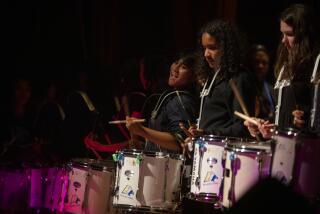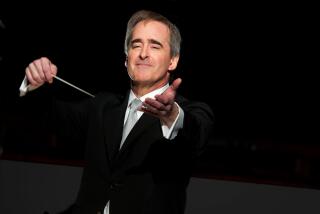Music Center cuts back its arts education at schools

Don Julian School teacher Robert London’s fourth-grade class shows off puppets they made as part of the Music Center’s in-school teaching program in their La Puente classroom.
Students at Don Julian Elementary School in La Puente studied the poetry of Langston Hughes and Maya Angelou this spring, but they did far more than just read and memorize the lines.
Teaching artists met each week with students, showing them how to make shadow puppets, then coaching them to deploy the puppets in a poetry performance for the class.
“We did a lot of things, like acting and making your voice big,” said Katherine Argueta, a recent fourth-grader.
“It was my favorite part of the day,” chimed in Jared Macedo, who said he would like to be an architect when he grows up.
The program came from the Music Center and is designed to tap into the fun and imaginative appeal of the arts, giving kids an enticing pathway into academic subjects.
But after decades of sending artists to work with students in Los Angeles County schools, the Music Center has cut its education department’s staff amid fundraising shortfalls. The teaching artist program students enjoyed at Don Julian Elementary and many other schools has been nearly eliminated.
The Music Center has long prided itself as a leader and innovator in arts education, but the drastic reduction of the teaching artists has some local educators questioning whether that is still the case.
“It was a national powerhouse program,” said Nicholas Goldsborough, a former chief operating officer of the Music Center who is now associate vice chancellor for fundraising at UCLA. “Unfortunately, it has lost a lot of the luster it once had.”
It will be up to Rachel Moore, the Music Center’s newly hired president and chief executive, to decide whether and how to reinvigorate its arts education programs.
“The performing arts is a fragile business. Sometimes people have to make tough choices to build a sustainable model,” Moore said when asked about the recent program cuts, after her hiring was announced last week.
Moore, currently the executive director of American Ballet Theatre in New York, has a 21-year track record of overseeing dance education programs at ABT and in Boston. She said that filling the vacant post of vice president for education at the Music Center is a crucial task she’ll tackle even before her starting date of Oct. 5.
Music Center leaders said the reductions in education aren’t budget-related but reflect strategic and philosophical changes initiated by its board members.
Howard Sherman, interim president at the Music Center, said its education department will focus on teaching regular classroom teachers how to incorporate the arts in lessons, in sessions that mainly will occur at the Music Center. More students will come to the Music Center to see performances.
In those ways, Sherman said, “we can reach far more kids in a deeper way.”
Sending teaching artists into the field to interact with students will continue for a handful of schools receiving special outside funding.
According to the description of the artist residency program on the Music Center’s website, it was considered “the Music Center’s most in-depth school program,” with aims that included “[helping] classroom teachers become more effective at teaching the arts [and] integrating the arts into other subject areas.”
For the 2013-14 year, 35 teaching artists conducted 382 artist residencies at 53 schools in 12 school districts, according to the Music Center’s annual report on its arts education programs.
A spokeswoman for the Music Center said it covered 50% of the cost of the program. Individual school districts made up the difference.
World music specialist John Zeretzke, who’d been a teaching artist for the Music Center for more than 30 years, said most of the residencies are for about two weeks and typically cost $3,000 to $4,000. Zeretzke said that about 25 of the Music Center’s teaching artists are exploring forming “a consortium” to keep the program going under new auspices — either independently or allied to an existing arts organization.
“Parents and schools want artist educators in the schools doing high-end work that represents exemplary art. It does not all happen on the hill,” Zeretzke said, alluding to the Music Center’s perch at the top of downtown’s Bunker Hill.
The teaching artists were independent contractors, but in recent months the Music Center has laid off five of 16 full-time employees in its education division, including Leonardo Bravo, the director of its school programs initiative. Mark Slavkin, the center’s vice president for education who oversaw all school and student-related programs, resigned in December. Slavkin said he didn’t know the layoffs were coming at the time he left.
“I was incredibly pained when the cuts were made,” said Slavkin, who now works at the Wallis Annenberg Center for the Performing Arts in Beverly Hills. But he added that the reduction in staff doesn’t mean the Music Center has abandoned its commitments.
Overall, the Music Center has seen its education-related expenditures decline by more than half since the most recent recession began, despite the improving economy and booming investment markets that have helped many other large arts organizations restore programs that had been cut. Its public financial statements show that the education division spent about $2.3 million last year, down from $4.8 million in 2006-07.
Among the more prominent cuts in recent years were the Bravo Awards, the annual ceremony to honor teachers in L.A. County schools for their contributions to arts education. The awards were given for 30 years starting in 1982, then were quietly discontinued after 2012.
Programs that will continue include the Blue Ribbon Children’s Festival, an annual one-day performing arts program that brings more than 15,000 fifth-graders to the Music Center; the Very Special Arts Festival for students with special needs; and “Music Center on Tour,” a concert program that is now the main vehicle for the Music Center to reach students at school sites.
“On Tour” figures for 2013-14 show that the Music Center mounted 383 school assemblies provided by 42 ensembles, reaching more than 63,000 students at 131 schools.
Some education leaders around the county described the reductions at the Music Center as a setback.
“It feels as if we’ve lost something big,” said Debbie Devine, head of 24th Street Theatre arts education company. “They had a huge vision and a huge reach.” For Devine, the cuts signal the Music Center’s retreat from its longtime standing as an admired and imitated leader in arts education.
“They were the role model,” she said. “It’s tragic.”
Robert Lee, principal of Sun Valley Magnet School, also thinks the Music Center is taking a wrong turn. “The resident artist model [provides] support, so the [classroom] teacher gets more comfortable integrating arts,” he said. Relying instead on teachers to go downtown to learn methods and bring them back “doesn’t transfer very well” in actual classroom practice.
Lee added that opportunities for trips to the Music Center are limited — impeded for some schools by the cost of renting buses but in his school’s case by a lack of slots for student groups. Lee said students from Sun Valley Magnet School have had one field trip to the Music Center during his four years as principal.
Others sounded a more optimistic note. “Even if the Music Center isn’t able to do all it has in the past, I believe other organizations will be able to step up. I think the Music Center is going to rebound,” said Rory Pullens, executive director of the arts for the Los Angeles Unified School District.
Pullens said LAUSD’s arts spending is itself on the rebound, expected to rise from the current $19 million to $24 million in the coming school year. He thinks it would take about $70 million in annual spending “to make the arts whole in LAUSD.”
The Music Center’s education division was launched in 1979 by Dorothy Chandler to make up for cuts in public school arts budgets driven by the passage of Proposition 13 in 1978. After 2000, two recessions and the No Child Left Behind program that emphasized testing in basic academic subjects led to further winnowing of many public school arts classes, which often were deemed to be outside the scope of what children most needed to learn.
For many students, working with teaching artists in their classrooms has meant more than learning a particular lesson.
“It helped me gain courage to speak in front of large groups,” said Alexander Cifuentes, a recent fifth-grader at Don Julian school. The school is part of the Bassett Unified School District.
“It’s a lot of fun,” said Robert London, a teacher at Don Julian. “And when you’re having fun, you learn and enjoy. It’s essential.”
“Who will be sad to see it go?” Darlene Chico, a teacher at Don Julian, asked her students on a recent morning. All of the kids in her combined fourth- and fifth-grade class raised their hands.
More to Read
The biggest entertainment stories
Get our big stories about Hollywood, film, television, music, arts, culture and more right in your inbox as soon as they publish.
You may occasionally receive promotional content from the Los Angeles Times.








